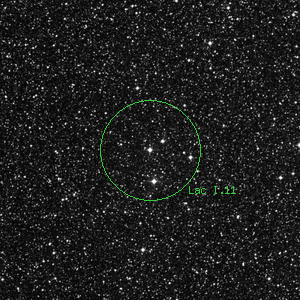Lac I.11 - NGC 6634

Overlaid DSS image of Lac I.11, 30' x 30' with north at top and west to the right
Aladin viewer for the region around Lac I.11
GC 5076
| Type | Asterism |
|---|---|
| Magnitude | 7.75 |
| Size | 10' |
| Right Ascension | 18h 30' 2.2" (2000) |
| Declination | 33° 29' 43" S |
| Constellation | Sagittarius |
Observing Notes
Andrew Cooper
Oct 7, 2020 Waikoloa, HI (map)
20cm f/6 Newtonian, Cave Astrola @ 76x
Seeing: 5 Transparency: 6 Moon: 0%
An asterism of four 8-9th magnitude stars in a rough box about 4' across, poor, fully resolved, in a very rich galactic starfield, this is probably Lac I.11 the other possibility being M69 about 1° north, Lacaille usually used a ½" aperture telescope for his southern survey making these four stars possibly appear nebulous where any less modest instrument clearly shows the asterism
Harold Corwin
NGC 6634 is probably the asterism of four stars at La Caille's position, but some doubt remains. John Herschel inserted the GC number into the GC's "Supplementary List" at the very end, without any notes as to why he was doing so. It's probable that he had seen the note in Auwers's 1862 reprinting of La Caille's list. Auwers called attention to the declination being a degree too far south for M 69, and also commented on Piazzi's note to the same effect that also included M 70 (see the GC and NGC Notes for John Herschel's rejoinder under the entry for M 69 = GC 4411 = NGC 6637).
In any event, La Caille's position would be 20 arcmin off M 69 without the one degree error. His description -- "It resembles a small nucleus of a comet" -- fits M 69 so well that Messier and many others have adopted the identity without even commenting on the position error. Glen Cozens, however, argues that M 69 is too faint (at V_total = 7.7) for La Caille to have seen with his 0.5-inch aperture telescope on the mural quadrant that he used to measure southern stars from the Cape of Good Hope, and further points out that the asterism of four stars is at La Caille's position (the eastern of the four stars is just south of the nominal position).
However, if La Caille saw M 69, it is not the faintest object that he found. That is the globular cluster NGC 4833 at V_total = 8.4; La Caille also found M 83 = NGC 5236 at V_total = 7.5 with a somewhat lower surface brightness than M 69. So, M 69 is clearly still a candidate.
La Caille's description is initially puzzling, though. But we need to keep that 0.5-inch telescope in mind. While he says that he had access to larger instruments, he also apologizes to his readers for rarely using them to examine the nebulae and clusters that he discovered. Given all this, his description makes perfect sense: the asterism, even though it is 4.0 arcmin across with a total V magnitude of 6.90 (Tycho-2 system), would appear as a faint blob of light.
By way of analogy, I recall my first view of NGC 7150 (which see) in my 6-inch reflector in the early 1960's: it appeared as a very small, elongated nebula. Yet on the POSS1 plates, it is a simple asterism of four stars (total V magnitude of 12.0) that is almost a direct copy of the asterism at La Caille's position, but faintened by 5 magnitudes and shrunk by a factor of about 50 in diameter. It must look in the 6-inch much as the four stars would look in a 0.5-inch telescope. Cozens reports that the asterism is an unresolved blob in 12x60 binoculars, and is easier to see than M 69 in the same instrument.
March 2009: Jeffery Corder has sent another visual observation, this time with a 6x30mm finder 'scope stopped down to half an inch. Here is his note:The 4-star asterism you mention is not resolved and appears nebulous. I would say that the asterism is what he (La Caille) actually saw. However, 10X or more would probably resolve the 4 stars, and under a superb dark sky, 6X would probably resolve the asterism -- based on my visual observations.However,I used a 0.5" offset mask on my F/10 C-8 and observed the asterism with a 55mm Plossl (37X). This is the lowest power I could get and it was still resolvable, easily.Given all this, I'm inclined to take La Caille's position and description at face value and keep L I-11 = NGC 6634 as a separate object. However, there is still a possibility, however slender, that it could be identical to M 69 = NGC 6637, so I include that as an alternative.
Other Data Sources for Lac I.11
Nearby objects for Lac I.11
6 objects found within 120'
| HD 170479 | HD 171034 | Kaus Australis |
| Messier 69 | NGC 6652 | PK2-9.1 |
Credits...
Drawings, descriptions, and CCD photos are copyright Andrew Cooper unless otherwise noted, no usage without permission.
A complete list of credits and sources can be found on the about page
Lac I.11